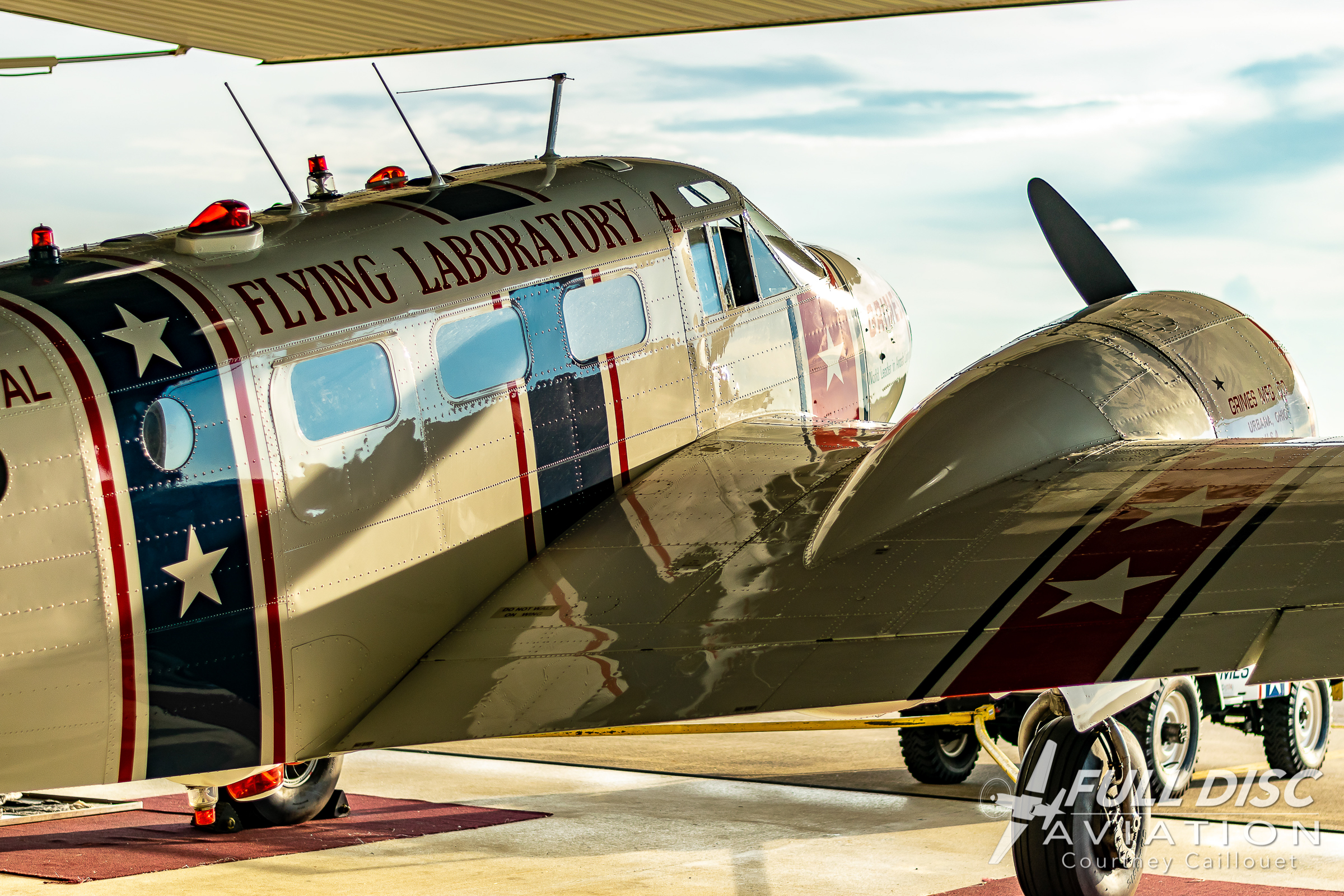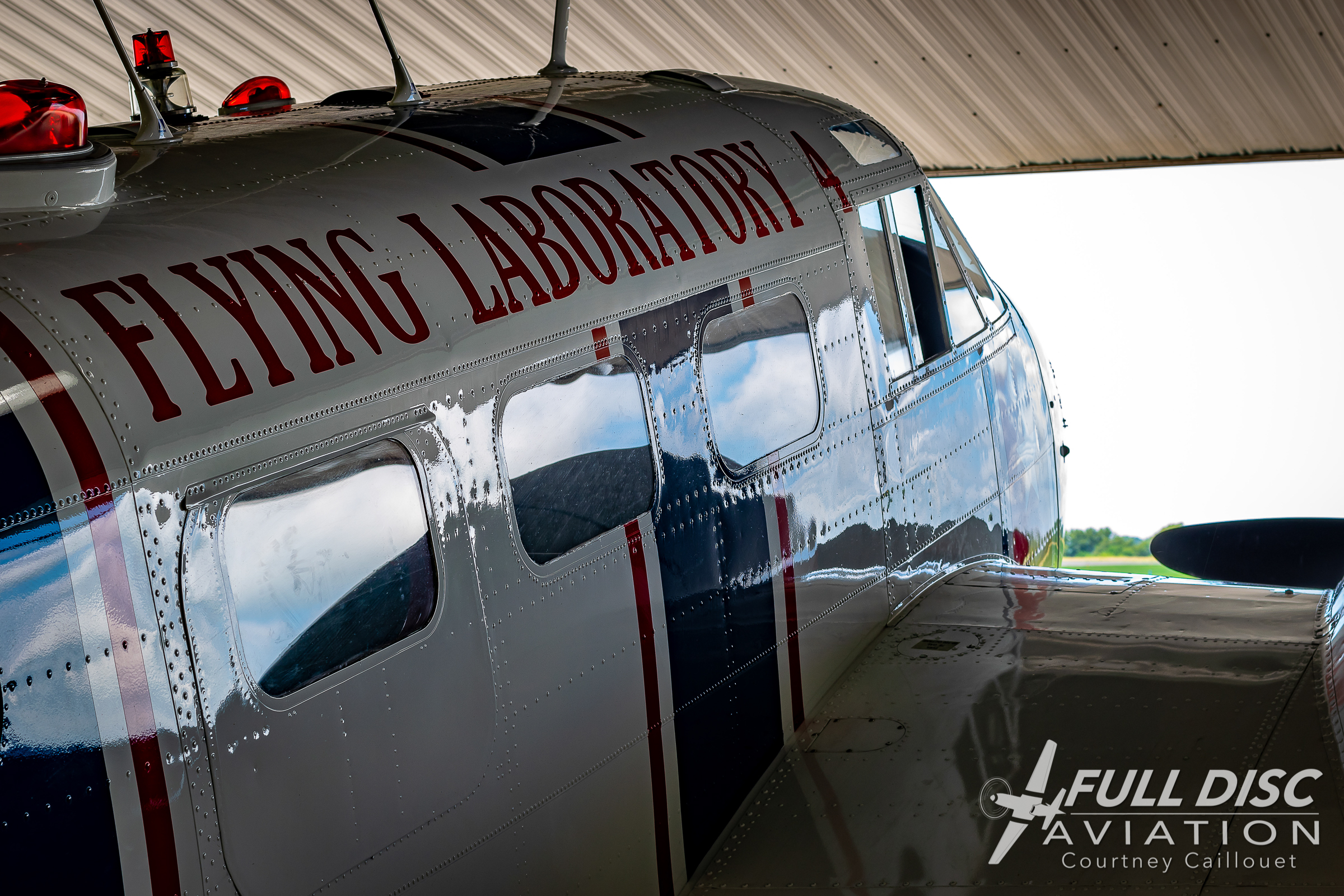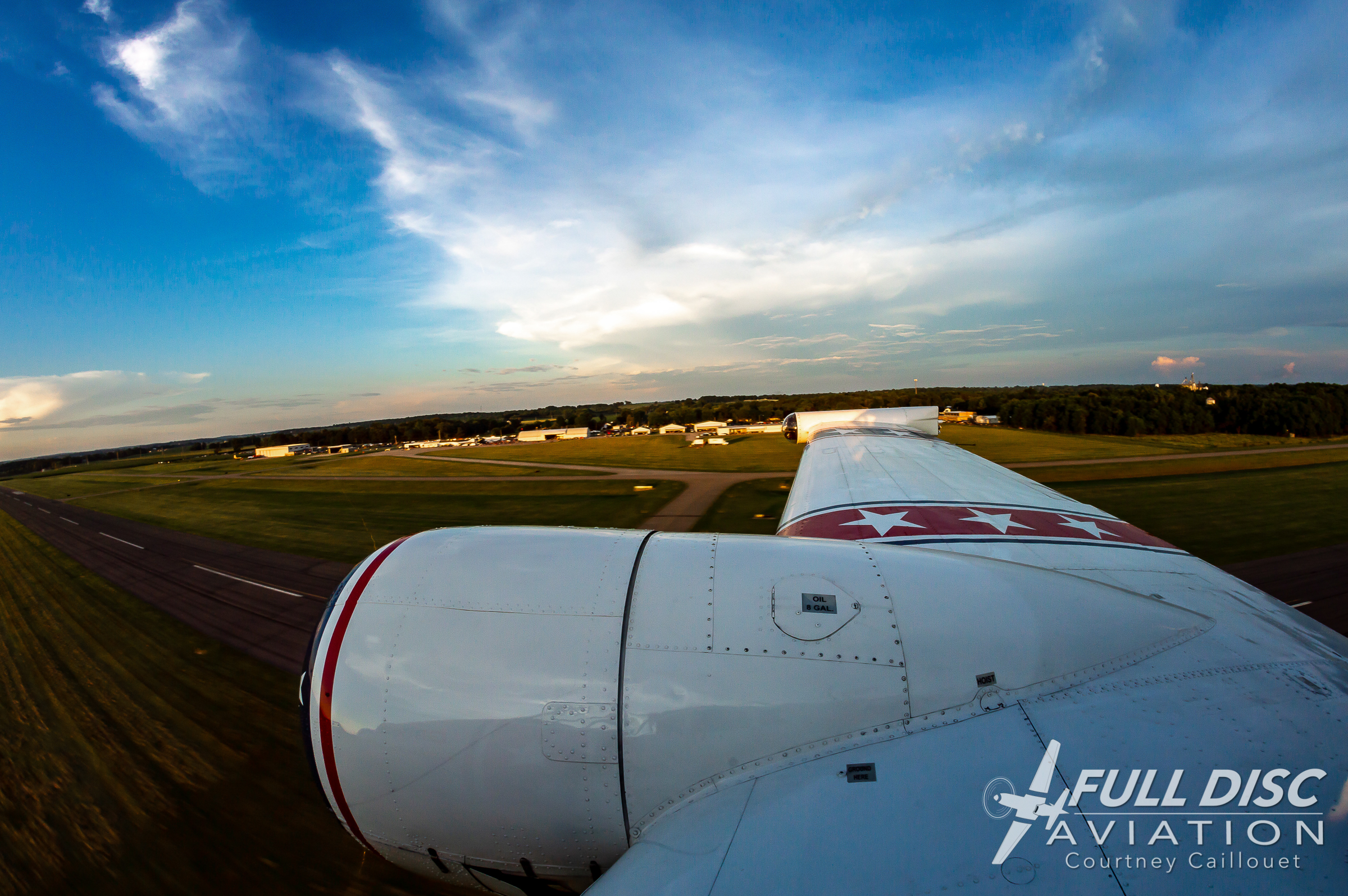Flying Lab
Prose & Photography: Guest Contributor Courtney Caillouet
Walking into the house, the air conditioning hit the massive beads of sweat on my face, instantly chilling them. Trying to do yard work in ninety degree weather was excruciating, but it helped keep my mind busy, distracting me from the possibilities of that evening. I picked my phone up from the desk. The time read 4:16 p.m. and there was a message: “What time are you coming? Dad says you can go up in the Lab and take pictures.” At first I felt a great deal of relief, but then my thoughts began to focus on the task at hand. This was no longer an illusion, but a reality. In a matter of hours, I would be riding in the co-pilot’s seat of the Grimes Flying Laboratory.
This all began as a chance meeting in 2016, when my family and I were the first ones in line for the grand opening of the National Museum of the United States Air Force’s newest hanger. Behind us were Debbie and Jessica, wife and daughter of the Chief of Restoration for the museum; Roger Deere. During our conversation, we discovered we had mutual friends at Grimes Field, which is a historic municipal airport about forty miles northeast of the museum. Once we got inside that day, I was introduced to Roger by Jessica. We began talking about the new hangar and its historic contents. His head was filled with history, facts and small details of the aircraft that occupied the Museum, after having worked there for almost thirty years. Living less than twenty miles away, I grew up in this place. I watched the museum’s collection grow as I grew, going from two hangars, to three, then four. Meeting Roger was exciting, as he could provide me with all kinds of new information about the collection. As we talked, I was overwhelmed with questions, but had so little time to ask them. My wife finally had to pull me away from Roger, almost physically, or we may have never left the museum that day. This brief meeting was just the beginning of a new friendship with him and his family.
Not only does Roger work for the USAF museum’s restoration department, but he is also a board member for The Grimes Flying Lab Foundation, a 501(c)(3) organization dedicated to the preservation of a C-45H, or known as a Beechcraft Model 18 in the civilian world . At one time, this aircraft was the test vehicle for Grimes Manufacturing. This company was the brainchild of Warren G. Grimes, becoming the first developer and manufacturer of aircraft lighting in the country. This was the fourth aircraft used by Grimes to test their aviation lighting, having been purchased in 1964. To test aircraft lighting designs, it was equipped with special wingtip pods to allow for the installation of anything the company’s engineers could dream up. There are also lighting fixtures on the top and bottom of the fuselage, as well as the nose and tail. In all, there are over sixty exterior lights on this single aircraft. The Lab was used by Grimes until 1986, when it was sold to a private party. But after thirteen years of outdoor storage and neglect, it was in poor condition and no longer airworthy. In 1999, the Grimes division of Allied Signal, bought the Beechcraft back and began her restoration. In 2003, a not-for-profit foundation was created and the restoration was taken over by volunteers, which included Roger. With his expertise, the Lab was back in the air by 2008.
The Lab is not an inexpensive aircraft to operate. At over $790 an hour, the foundation limits her flying to paid events. In July of 2017, I heard they would be doing a fly-over for a local parade, so I made the trek to Grimes to see her in action for the first time. Of course my cameras came along, allowing me to get some amazing shots of this beautifully restored twin Beech in flight. It was a quiet day at the field and one of the Lab’s volunteers drove me out to the runway, giving me the opportunity to get in close for takeoff and landing photos. I provided copies of my shots to Jessica, who promptly shared them on the foundation’s Facebook page. When Roger saw them, he proposed the idea of me going up in the Lab so I could get some photos of her vast array of aircraft lights in action. This was a very exciting proposition to say the least, but one I knew would be a challenge to make happen. With limited flights each season, working out a time that would fit both my schedule, as well as the foundation’s, would be tricky. For nearly a year, it was simply a dream.
About mid-June of 2018, I had a thought one day while at work: What about the 4th of July event? Knowing the city of Urbana uses Grimes Field for their fireworks display, the Flying Lab Foundation takes that opportunity to show off the Lab’s many lights, making several fly-bys at dusk. This could be the opportunity we were looking for. I grabbed my phone and fired the idea off to Jessica, asking her to pitch it to her dad. Jessica agreed it would be the perfect time and said she would discuss it with Roger.
Despite still not having an answer by that morning, my wife and I still had plans to spend the evening of the 4th at Grimes. Not being an aviation fan, she’s never made the trip to the field with me. I have made a lot of good friends there, which she was interested to meet. I was excited she wanted to spend the holiday at one of my favorite places and we would be able to make it a family event. I also knew that regardless of whether or not I would be in the right seat of the Lab, it would still be a fantastic chance to get some ground shots as she made her passes. Once I received the 4:16 p.m. message that I was going up, my excitement level tripled. The heat and humidity were almost unbearable that day, but I wasn’t going to let that stop me. For nearly a year, I had been dreaming about this and trying to figure out how to make it happen. It was now or maybe never.
We arrived at Grimes around six o’clock. Jessica said takeoff time would be sometime between 8:30 or 9:00 p.m., so I wanted to get there with plenty of time to spare. We did a little walking around so my wife could meet my airport friends and see some of the field. The heat was intense, but certainly didn’t hamper my enthusiasm. I love this historic place and its people. To have the whole family there was a huge plus!
We eventually made our way to the Flying Lab’s hangar. I popped my camera bag onto a table and readied my equipment. I checked my SD cards, my battery levels and made my lens selections. I planned to use three bodies. Attached would be a 50mm f/1.8 prime, an 18-35mm f/5.6 zoom, and my trusty 8mm fisheye for some wide-angle perspectives. Taking all my cameras would allow me several lens options, while limiting change outs in such a confined space. I also like to keep loose objects out of cockpits. Having things rolling around inside a moving aircraft could certainly spell disaster. Plus, I would be shooting through an open window, so I knew my triple camera harness was a must. Despite my wife’s refusal to be seen with me in public while wearing three cameras, safety comes first. She would just have to deal with me looking like a nerd for a couple hours.
While I was prepping everything, I was approached by Paul McClaskey, the pilot for that evening’s flight. After introductions were made, we chatted a bit. He told me that he had been flying the Lab since 2012 and that he felt honored to fly such a treasured aircraft. We then discussing some safety concerns, as well as what he needed to do for me to get the best shots. He told me what the usual routine was for the 4th of July flight and then left me to my equipment prepping with the words; ”Be sure you’re close by at about 8:30. That’s when things are going to get serious.”
Where would I go? I was there to make this photo adventure happen and I wasn’t going to miss it for anything! I stayed in the hangar, never letting the Lab out of sight. The hangar itself doubles as a museum for the preservation of the Grimes Corporation’s history, with plenty of artifacts and displays to see and read. I’ve been there many times before, but I always find something that piques my interest. And with the yellow-orange light of the setting sun, it gave me a chance to get some static shots of the Lab as she was illuminated from the west. The patriotic red, white, and blue livery of the twin Beech looked fantastic, as light was now pouring in through the open hangar. While looking for new and different angles to shoot, I was caught a little by surprise when Roger fired up the Lab’s support vehicle. The sound of the Willy’s engine meant it was time. I quickly grabbed my gear and made my way back to the blazing tarmac, the heat having yet to be abated by the now setting sun.
I went to work, using my camera to document the movement and prep work of this beautifully restored aircraft. With golden hour quickly approaching, this gave me a chance to fine-tune my camera settings as well. The Beech finally made it onto to grass, away from the crowd gathering for the celebration. There I met Dave Youtz. He’s one of only two people who are trained to operate the light array, which is controlled from a large panel sitting directly behind the co-pilot’s seat. Once Paul was on board and settled into the cockpit, I climbed in and made my way into position. It’s quite the task maneuvering a tight fuselage and into a cramped cockpit, while three cameras hang from your body. By the time I was seated and secured by the Lab’s safety belt, I was drenched with sweat. The small cockpit windows hardly allowed enough flow to push out the humid air.
Dave came aboard and took his position at the lighting panel. The door was secured and Paul began the pre-flight checks. Very soon, he had the engines fired up. The airframe shuttered and shook with both Wasp Juniors turning the props at full. As the radial’s temperatures were built up and everything checked out on the gauges, we were on the move. We stopped just shy of the southern runway threshold to do one more engine run-up, continuing to check that everything was working as it should. We then moved into our takeoff position on the runway. Paul made a radio broadcast stating our intent, scanned the airspace one last time and pushed the throttles to full power. With the release of the brakes, we rapidly moved down the runway. I glanced to the east and saw how large the crowd had grown. The people of Urbana are very familiar with the Flying Lab, having had relatives and neighbors who were employed by the eighty plus year old Grimes Corporation, some having worked there themselves. The company was eventually purchased by Honeywell, who still employs a number of Urbana’s residents. This aircraft is like a member of the community.
Before reaching the center of the runway, I could feel the wings gaining their grip on the humid air and I could see the controls starting to lighten. Paul gently eased back on the yoke and the distance between us and the ground began to grow. At the end of the airport property, the gears were up and the airframe began to smooth out. Dave requested a fly over of friend’s nearby farm, as they were having a barbeque. We made several small circles at 2000 feet, just to the north of the city as he and Paul tried to locate the farm. While banking toward the west, I could see a lovely sunset beginning to take shape. It would still be a good forty or so minutes before it would really start to dip below the horizon, but the colors were already becoming intense. The search was called off for the barbeque crowd and Paul said we would start flying over downtown, broadcasting the 4th of July celebration to the rest of the city.
Dave started firing up the lights. Despite the droning noise coming from the massive R-985s, I could hear the electricity flowing from the capacitors as it was sent to the strobe lights. It was still too bright for me to see the flashes coming from the wingtip pods, so I focused my attention on the setting sun. The yellow, orange, and red colors were beginning to deepen, spilling through the thin cloud bank on the horizon. We kept the altitude around 2000 feet, making several passes over the city. On the final pass over downtown, Dave said he wanted to find the old Grimes plating facility, which Honeywell had just announced the closing of that week. He wanted me to try and get a shot of the plant with the Lab’s wing in the foreground. It took a couple passes to get it lined up correctly, but I felt like I got a shot that was worthy of those who would soon be out of a job. It was a nice sentiment.
With that task complete, it was time to focus on the crowd that had already gathered for the Independence Day festivities. Paul made one pass over the runway, then he came back around to line up for a landing. He said the oil temp on the starboard engine tends to run a little hot and he wanted to bring it down to allow for a short cool down before the dusk flight, which is when the aviation lights really stand out. It was also at this point that he felt he should give me a warning. In a humorous fashion, he told me that his landings weren’t always pretty, but they were always successful. Some people would get concerned by a statement like that, but I just laughed and told him that I had plenty of faith in his ability. The landing was a bit bumpy, but not as bad as he’d made it out to be. I think this was more pilot humor than an actual criticism of his skills. Moving onto the taxiway, we faced the south and sat for about ten minutes with the engines idling. Once he felt like the temperature was back at a comfortable level, we were headed back up.
By this time, the crowd size had increased even more, and there were multiple carloads parked along Route 68, just to the north side of the field. I could see kids waving as we pulled up and lifted back into the sky. Now the sun was really starting to dip and Paul told Dave to fire up everything on the aircraft. With the panel right behind me, I could hear the flipping of switches and the hum of surging electricity. We made a hard left, leveling out once the compass read SOUTH. This gave me the opportunity to shoot the setting sun against the wingtip pods. With the natural light retreating, it was also the first time the wingtip lights were beginning to show from my vantage point. Reaching the water tower on the southern side of Urbana, Paul pointed the nose north and started heading back toward Grimes. Approaching the field, we began our descent with all of the lights ablaze. We buzzed the runway around 500 feet, allowing the crowd to see the vast colors in the twilight. Pulling back on the yoke, we followed the same course to line up for one more spirited pass. This one was identical to previous pass, but ended with a little more excitement. At the end of the field, Paul pulled back on the yoke and banked left. This put the Beechcraft into a climbing turn toward the remains of the sunset. The g-forces pushed against my camera gear, pressing them deep into my abdomen.
Leveling off, the sky was now a dark blue, with the illumination of the lighting flashing and reflecting off of the Lab’s wing. Once we leveled out, Dave killed the power as we headed south for the final time. I could now see the lights of the city under us. With the sun below the horizon, a large number of the city’s residents had decided to start their own celebration, launching fireworks as we flew overhead. As Paul made the landing approach, there were flashes from skyrockets coming up from all over the city. It was a lovely sight, however a bit worrisome, as a few were a little too close for comfort. Our second landing was about as bumpy as the first, but again, we were safely on the ground. As we taxied back toward the ground crew, we could see Roger waving us in with a pair of marshalling wands. When we were within a couple hundred feet, Paul came over the radio and said, “Not yet Roger!” He told Dave to fire up the lights one more time, giving the tail dragger hard rudder, putting her into a purposeful ground loop. This was the first time I’d ever done a doughnut in an airplane! With the noise of the engines, I couldn’t hear for sure, but I imagined the crowd loved this final display. We taxied up to the waiting ground crew and exited the aircraft once everything was powered down. I thanked everyone for such an incredible experience then joined my waiting family for the fireworks. After my ride in the Flying Lab, the pyrotechnics seemed so insignificant.
This was an Independence Day celebration of a lifetime. I was able to watch the sunset from the right seat of an airplane that I have admired for several years. I feel so blessed to have become friends with the Deere family and will be forever grateful to them for allowing me to have this opportunity.
The Lab flies like a dream. I couldn’t have imagined it would be such a smooth and comfortable flight. Beechcraft certainly had a winning design with this machine, which is a testament to its lengthy production. All over the United States, there are organizations preserving aircraft like the Flying Lab, sustainable only on donated funds. For the last year, the Lab’s foundation has been working hard to get the aircraft out to more events, thus giving more people exposure to this beautifully restored C-45H. This has been quite the financial undertaking. Shortly before my fight, the Lab was flown to Wisconsin to have the main spar inspected. Although it passed, this set the foundation back over $14,000. Now before this flying season begins, it has been suggested that the propellers be removed and sent out for a similar analysis. Once completed, the foundation will be able to increase the number of events, even stretching the distance in which she can fly. It’s supporters who keep these historic old birds in the air and every dollar counts. The Flying Lab Foundation realizes that they need to get her out to the masses, allowing as many people as possible to see this one-of-a-kind airplane, hopefully allowing her to continue flying for many generations to come.





































